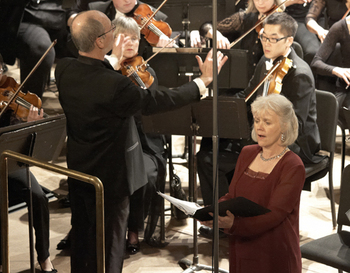Ann Arbor Symphony Orchestra closes its season with vivid Mahler's Third Symphony

Music Directory Arie Lipsky leads the Ann Arbor Symphony Orchestra and soloist Freda Herseth in Saturday night's season-ending concert.
photo by Czarnecki/Dempsey
It takes a village — women’s chorus, children’s chorus, alto soloist, giant orchestra — to mount a performance of Mahler’s monumental Symphony No. 3 in D minor. That our town can be that village is as wondrous a thing as the music itself, and it gave an extra measure of excitement to the Ann Arbor Symphony Orchestra’s Mahler 3 Saturday night at the Michigan Theater, in the orchestra’s season finale under Music Director Arie Lipsky.
But home-town pride aside, the A2SO — with the Women of the UMS Choral Union, the Ann Arbor Youth Chorale and mezzo-soprano Freda Herseth (substituting for an ailing Melody Racine) — offered soul-satisfying Mahler Saturday, capping its season with playing that was committed, assured, alert to Mahler’s kaleidoscopic moods and to the music’s ever-upward trajectory toward the light.
The bookends of the symphony — its lengthy first movement, in which nature awakes; and its capstone sixth movement, in which love illuminates the world and opens the heavens — were both vividly rendered.
In the first, the brass were remarkable, gleaming in their announcements, raw in their shriekings; but so were the cellos, entering with gritty determination, and the winds, with their parade-ground marching, all abetted by the percussion. The textures — whether in chamber music-like passages that provide such contrast to the big orchestral sections — were clear and bracing. That was true throughout the entire work.
In the serene and glowing sixth movement, perhaps what said most about the playing was how much one felt the urge to bow one’s head at the strings’ prayerful entrance.
But that urge also said a lot about the music-making that preceded, especially in movements four and five, crucial steps on the journey Mahler has set out for us. As soloist in the fourth movement — mankind’s night, dark, hushed and pensive — Herseth had the right furrowed vision of the Nietzsche text and the sound to declaim it as such; when day dawned, in the fifth movement, with the children and women’s choruses joining her, the sound was bright and joyous, easy and innocent.
The colors elsewhere were equally seductive, from the gentle shades of the minuet (played with terrific rhythmic sensitivity) to the chirping forest cacophony of the third-movement scherzo, set in such marvelous contrast to the off-stage posthorn interludes. Lipsky conducted, as usual, without a score, a feat in itself in a score this complex and nearly two hours in length. He looked wrung out at the end, but happy. And he had reason enough for both.


Comments
Rene
Mon, May 2, 2011 : 2:54 p.m.
I am glad that at the last minute we were able to attend this concert (with my 11 yo son). It was my first AASO concert, and not only was it a great experience, but it is really a testament to the hearts of all the people that make up the AASO. This is a score that brings world famous orchestras and directors to their knees and the AASO was excellent throughout. I hope they recorded the concert and we can buy it in the near future. I also hope they perform more Mahler after this wonderful example. They showed they have the musicianship and stamina to do all of them (but they will need a bigger venue for the 8th). I was also very happy to see so many women are part of the AASO, definitely not a Boys Club like the Vienna SO. Bravo AASO!! Rene'